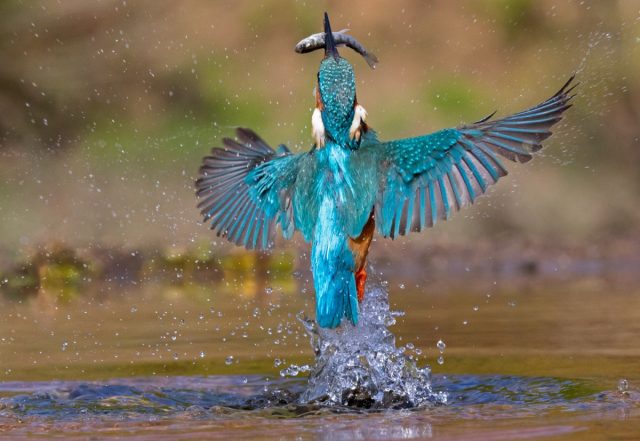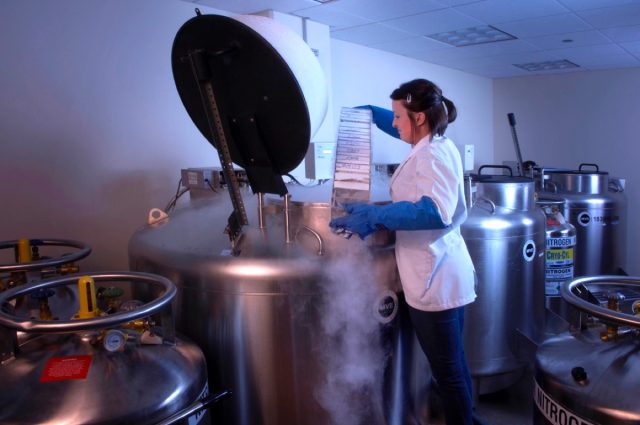

Richard Towell
There are many different species of kingfisher, and those that eat fish hunt by repeatedly diving head-first into the water when they spot tasty prey without suffering brain injuries like concussions. It turns out that diving kingfishers have several modified genes associated with diet and brain structure, according to a new paper published in the journal Communications Biology—notably mutations in genes related to the tau proteins that help stabilize neuron structure, although they can be harmful if too many build up.
“I learned a lot about tau proteins when I was the concussion manager of my son’s hockey team,” said co-author Shannon Hackett, associate curator of birds at the Field Museum. “I started to wonder, why don’t kingfishers die because their brains turn to mush? There’s gotta be something they’re doing that protects them from the negative influences of repeatedly landing on their heads on the water’s surface.”
It’s not the first time scientists have pondered this question, not just for kingfishers, but for other birds like gannets and woodpeckers. For instance, physicists at Virginia Tech studied diving gannets back in 2014 (publishing their conclusions in 2016), which fold their wings back as they dive, hitting the water with their whole body to snag underwater prey. From a physics standpoint, we’re talking about an elastic body hitting the surface of water as fast as 55 MPH. The stress of moving from the medium of air to the much denser medium of water exerts a huge force on the bird’s body, with an impact akin to tornadoes hitting the water. Yet despite the stress on their bodies, gannets (like the kingfisher) manage the feat again and again without injury, especially concussions.
So Sunny Jung and his team snagged a deceased gannet from the Smithsonian’s Natural History Museum and froze it, then dropped the bird repeatedly into tanks of water while capturing the process with high-speed cameras. (The unfrozen body was just too floppy to be used in the experiments.) They also made 3D-printed models of gannets based on CT scans of their specimen and repeated the experiments, which enabled them to vary different characteristics.

Richard Towell
They found that the second stage of the diving trajectory was the danger zone for a diving bird—when the head is fully immersed in the water but the body is still in the air—because it produces a very strong compressive force on the neck. Gannets have very long necks (half their body length), which can buckle easily if the birds dive faster than a certain speed; gannets have figured out the speedy sweet spot for safety. They get added protection from the pointy shape of their beaks, reducing the force on the body.
Kingfishers also have distinctively shaped beaks: long, narrow cones that can enter the water without creating a compression wave beneath the surface. Back in 2005, the engineers who designed Japan’s famous bullet trains adapted their design based on kingfisher beaks. Half of the Sanyo Shinkansen Line consists of sections of tunnels, and trains rushing into a tunnel at very high speeds generate strong atmospheric pressure waves akin to the compression waves produced by diving birds. In the case of the trains, the resulting sonic booms and vibrations can make for an uncomfortable ride. Changing the shape of the trains’ noses to resemble that of a kingfisher’s beak reduced the air pressure by 50 percent while enabling them to increase speeds by 10 percent.
Scientists at Bangor University confirmed in a 2019 study the importance of beak shape in protecting kingfishers when they dive. That study also used 3D-printed models—in this case, models of beaks of many different kingfisher species, both diving and non-diving varieties. They measured how the speed of entry changed upon impact with the water and concluded that longer, narrower beak shapes were the most efficient. That means the green-and-rufous kingfisher performed the best (according to the Bangor team’s criteria), followed by the Amazon kingfisher and the beach kingfisher in second and third place, respectively.

Kate Golembiewski
This latest study investigated the underlying genetic influences of kingfishers’ ability to dive without injuring themselves. Previously, two of the co-authors (Jenna McCollough and Michael Andersen of the University of New Mexico) had used DNA analysis to demonstrate that kingfishers evolved to dive and eat fish several times, rather than stemming from a common ancestor. “The fact that there are so many transitions to diving is what makes this group both fascinating and powerful, from a scientific research perspective,” said Hackett. “If a trait evolves a multitude of different times independently, that means you have power to find an overarching explanation for why that is.”
Hackett and her co-authors were able to analyze the DNA of 30 different kingfisher species (both diving and non-diving), thanks to the Field Museum’s extensive collection of tissue samples, kept frozen in liquid nitrogen. After sequencing the full genome for each, the team then compared the many billions of pairs to find any genetic variations shared by the diving kingfishers in particular.
Among the more interesting results: mutations in the MAPT gene that codes for tau proteins. Proper functioning of this gene might mitigate concussion in woodpeckers, for example, and the same seems to be true of the kingfisher, along with adaptive evolution of beak shape and brain shape. “The same genes that keep your neurons in your brain all nice and ordered are the things that fail when you get repeated concussions if you’re a football player or if you get Alzheimer’s,” said Hackett. “My guess is there’s some sort of strong selective pressure on those proteins to protect the birds’ brains in some way.”

John Weinstein, Field Museum
The next step is to try to pin down what effect these genetic mutations are having on the proteins being produced, as well as the underlying mechanisms of how such changes might protect the brain from concussion. They would also like to further investigate a surprising finding that effective population size fluctuates more for island-based kingfishers than those who live on continents, given that this conclusion was based on just three island-based diving species and hence is rather tenuous.
DOI: Communications Biology, 2023. 10.1038/s42003-023-05359-z (About DOIs).

